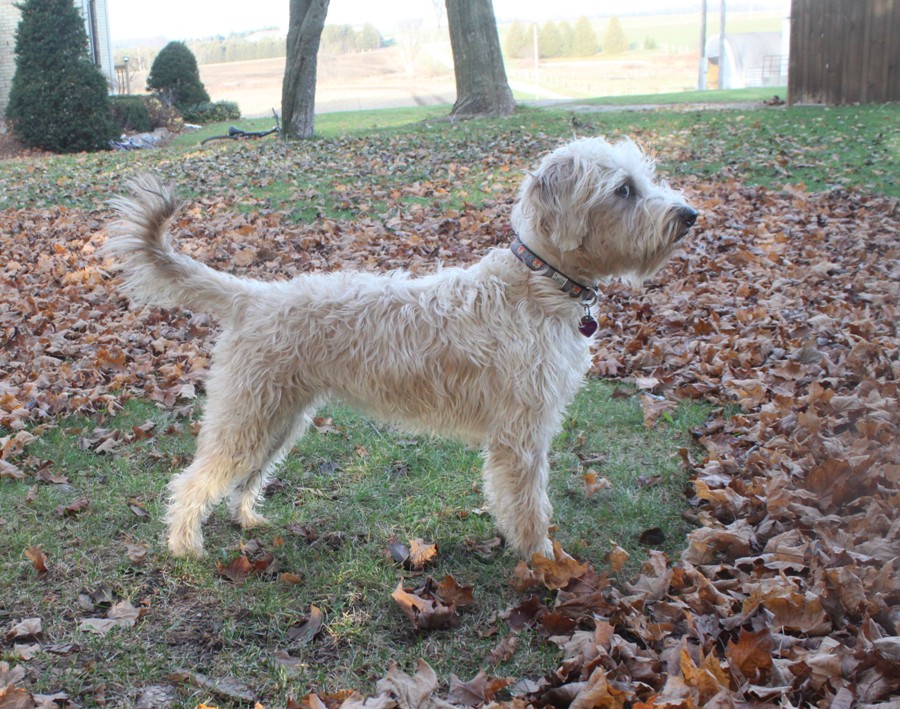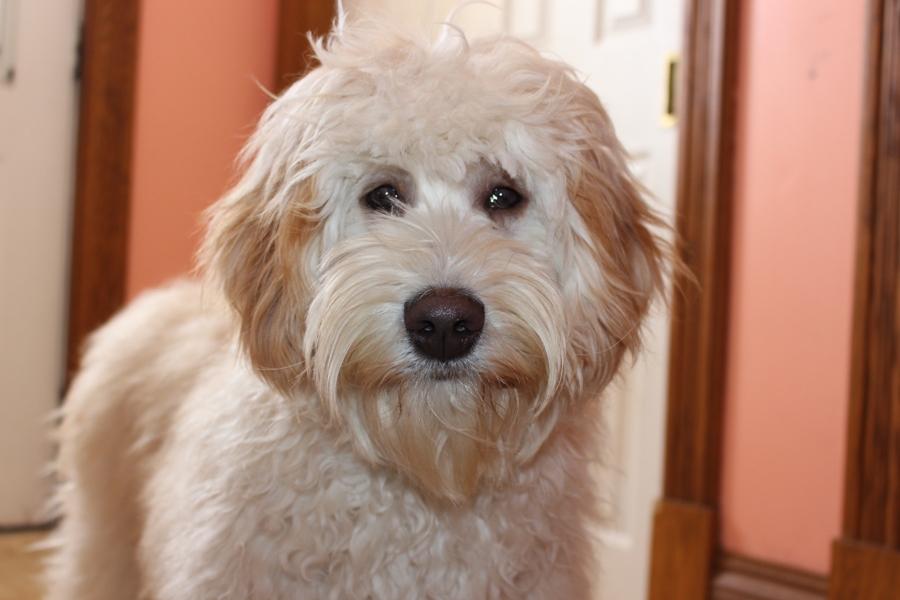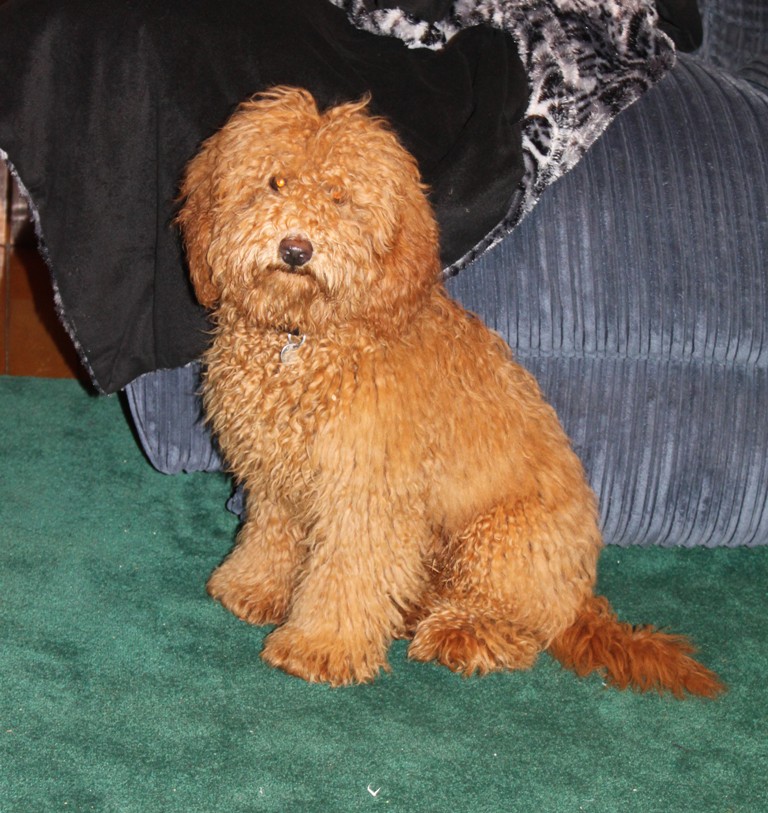Coat Types, Colours & Care
Labradoodle Coats
Learn About Coat Types & Colours
Labradoodle Coat Types

Loose Fleece
This coat is a very open, thin fleece coat. Hypoallergenic, may shed a bit as the coat transitions from puppy to adult. In adolescence this coat can look wiry. By 2 years of age the coat has matured and is a shimmering silk, BEAUTIFUL!

Full Open Fleece
This is a full bodied fleece coat. The puppies are born with this coat and there is not much change through out the life of the Labradoodle. The coat still transitions from puppy to adult and one needs to be careful of mats during this time. Super soft and lovable!

Spiral Fleece / Open Wool
The Spiral fleece/ Open Wool coat is like a lamb’s wool in texture. It has the appearance of looser spiralling fleece/wool, which opens up easily to the skin. It will not appear thick and dense or tightly curled. Super soft and has that darling teddy bear look!
Labradoodle Colours
- All solid colours
- Colours of Parchment, Lavender, Cafe’ and Chocolate may have dark amber eyes; liver noses, eye rims and lips; and dark nails.
- Colours of Caramel may have dark amber to pale hazel-green eyes; liver noses, eye rims and lips; and self coloured to dark nails.
- Colours of Gold, Red, Black, Blue and Silver must have very dark eyes; black noses, eye rims and lips; and black or self-coloured nails.
- Colours of Chalk and Cream may have either pigmentation of dark amber to pale hazel-green eyes; liver noses, eye rims and lips; and self coloured to dark nails or very dark eyes; black noses, eye rims and lips; and black or self-coloured nails.
- Solid. Colour is solid and preferably even, preferably with no white markings. A small white flash no larger than 2.5cm in diameter can appear on the chest, feet or tail and is permissible. Even colours are preferred but natural colouration of the coat is not considered a fault. Within the solid colour category there are a range of different colours:
- Chalk, This colour should be a white colour but when compared to white is rather a chalkywhite in colour. Nose pigment to be Black or Rose.
- Cream, This colour should be a creamy colouring sometimes with apricot/gold tinting, all shades of cream are acceptable. Nose pigment to be Black or Rose.
- Gold, This colour has also been referred to, as “apricot” should be the colour of the inside of a ripe apricot to varying shades of rich Gold in colour. A true Gold should not have a lighter root than the outer coat and preferable have an even colouration over the entire body. This colour may fade as the dog grows older. Nose pigment to be Black in colour.
- Caramel, This colour ranges from a rich gold through to a deep red the preferred colour is very much the same colour as its namesake ‘caramel’ with even colouration over the entire body. Nose pigment to be Rose in colour.
- Red, This colour should be a solid even rich red in colour. A true red should not be lighter at the root than the outer coat. Reds can fade as the dog grows older. Nose pigment to be Black. [Rare colour group]
- Black, This colour should be a solid black in colour with no sprinkling of any other colour through the coat. Nose pigment to be Black.
- Silver, This colour can range in shades from very light pewter in colour to a dark charcoal in colour it is preferred to see an even colour through the coat but acceptable to see uneven layering of colour in the coat. Silvers are born Black with the coat colour developing over time (1-3 yrs). Nose pigment to be Black.
- Blue, This colour should be a dark to medium smoky blue in colour. Blues are born Black but will have a Blue/Grey skin pigment. The blue coat colour will develop over time (1-3yrs) but as a developed adult should have an even coat colour. Nose pigment to be Blue/Grey [matching the skin pigmentation]. [Rare colour group]
- Chocolate, This colour should be a dark rich chocolate in colour. True chocolates are born almost black in colour and maintain the rich dark colour throughout their lifetime. Colour should be even. Nose pigment to be Rose in colour [matching the coat colour].
- Café, This colour ranges from a milk chocolate to silver-beige in colour and will develop over time (1-3yrs). Nose pigment to be Rose in colour [matching the coat colour]
- Lavender, This colour has a definite smoky lavender chocolate colour giving an almost pink to lilac appearance. Lavender dogs are born chocolate and will develop over time (1-3yrs). Nose pigment to be Rose in colour [matching the coat colour]. [Rare colour group]
- Parchment, This colour is a creamy beige chocolate colour reminiscent of a cup of coffee with a generous addition of milk. Parchment dogs are born milk chocolate and will develop over time (1-3yrs). From a distance adult dogs can be mistaken for a dark or smoky cream. Nose pigment to be Rose in colour. [Rare colour group]
- Parti: Colour is fifty percent white, with spots/patches of any other solid colour. No set pattern is required but symmetrical markings on the head are preferred. Freckling of the solid colour in the white of the coat is acceptable but not encouraged.
- Phantom: The body colour must be a solid colour with defined markings of a second colour as follows: above each eye, on the sides of the muzzle, on the cheek, on the underside of the ears, on the throat to fore-chest, or in a chin and fore-chest pattern, with a minimum second colouring on the feet preferably up the legs, and below the tail. Second colour in the inside of the leg and flank is also acceptable and should not be penalized. Markings are preferred to be clear and defined. Face markings of the second colour with the entire face coloured is acceptable, though not preferred, if the other required body markings are present. Any of the solid colours combination is acceptable.
- Abstract: Any solid colour with the second colour being white, must have less than fifty percent white.
- Sable: Black-tipped hairs on any solid colour, preferable even but no penalty for uneven pattern of ticking.
- Brindle: Should have an even and equal distribution of the colours with layering of black hairs in regions of lighter colours (usually, chalk/cream/gold/red, cafe/lavender/parchment, or silver) producing a tiger-striped pattern.
- Multi: Multiple colours or patterns, as in a phantom with large white Abstract markings, or a Parti pattern with Sable ticking etc…
Labradoodle Care
It is normal that all Labradoodle colours may show bleaching and discolouration over the top coat, referred to as sunning, this is quite expected and acceptable. The Australian Labradoodle is an active dog and often a service dog that enjoys the outdoors.
